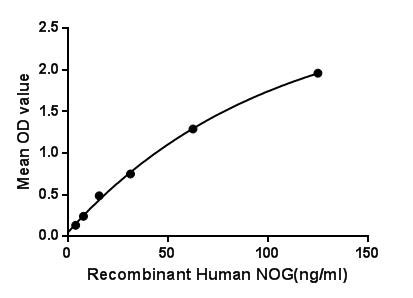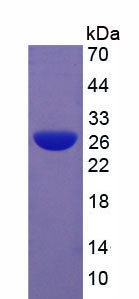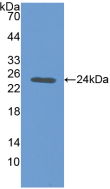Active Noggin (NOG) 

SYM1; SYNS1; Synostoses(Multiple)Syndrome 1; Symphalangism 1(Proximal)
- UOM
- FOB US$ 222.00 US$ 554.00 US$ 1,108.00 US$ 3,324.00 US$ 8,310.00
- Quantity
Overview
Properties
- Product No.APC130Hu01
- Organism SpeciesHomo sapiens (Human) Same name, Different species.
- ApplicationsCell culture; Activity Assays.
Research use only - DownloadInstruction Manual
- CategorySignal transductionImmune moleculeNeuro scienceBone metabolism
- Buffer Formulation20mM Tris, 150mM NaCl, pH8.0, containing 1mM EDTA, 1mM DTT, 0.01% SKL, 5% Trehalose and Proclin300.
- Traits Freeze-dried powder, Purity > 95%
- Isoelectric Point9.1
Sign into your account
Share a new citation as an author
Upload your experimental result
Review

Contact us
Please fill in the blank.
Activity test

Figure. The binding activity of NOG with CDF5.
Noggin, also known as NOG, is a protein that is involved in the development of many body tissues, including nerve tissue, muscles, and bones. Noggin is a signaling molecule that plays an important role in promoting somite patterning in the developing embryo. It is released from the notochord and regulates bone morphogenic protein (BMP4) during development. It also causes formation of the head and other dorsal structures. Besides, Growth Differentiation Factor 5 (GDF5) has been identified as an interactor of NOG, thus a binding ELISA assay was conducted to detect the interaction of recombinant human NOG and recombinant human CDF5. Briefly, NOG were diluted serially in PBS with 0.01% BSA (pH 7.4). Duplicate samples of 100uL were then transferred to CDF5-coated microtiter wells and incubated for 2h at 37℃. Wells were washed with PBST and incubated for 1h with anti-NOG pAb, then aspirated and washed 3 times. After incubation with HRP labelled secondary antibody, wells were aspirated and washed 3 times. With the addition of substrate solution, wells were incubated 15-25 minutes at 37℃. Finally, add 50µL stop solution to the wells and read at 450nm immediately. The binding activity of NOG and CDF5 was shown in Figure 1, and this effect was in a dose dependent manner.
Usage
Reconstitute in 20mM Tris, 150mM NaCl (PH8.0) to a concentration of 0.1-1.0 mg/mL. Do not vortex.
Storage
Avoid repeated freeze/thaw cycles. Store at 2-8°C for one month. Aliquot and store at -80°C for 12 months.
Stability
The thermal stability is described by the loss rate. The loss rate was determined by accelerated thermal degradation test, that is, incubate the protein at 37°C for 48h, and no obvious degradation and precipitation were observed. The loss rate is less than 5% within the expiration date under appropriate storage condition.
Increment services
-
 BCA Protein Quantification Kit
BCA Protein Quantification Kit
-
 Molecular Mass Marker for Protein
Molecular Mass Marker for Protein
-
 Monoclonal Antibody Customized Service
Monoclonal Antibody Customized Service
-
 Polyclonal Antibody Customized Service
Polyclonal Antibody Customized Service
-
 Protein Activity Test Experiment Service
Protein Activity Test Experiment Service
-
 Electrophoretic Mobility Shift Assay (EMSA) Experiment Service
Electrophoretic Mobility Shift Assay (EMSA) Experiment Service
-
 Buffer
Buffer
-
 Lentivirus Packaging Experiment Service
Lentivirus Packaging Experiment Service
-
 Adenovirus Packaging Experiment Service
Adenovirus Packaging Experiment Service
-
 Real Time PCR Experimental Service
Real Time PCR Experimental Service
-
 Spike RBD Protein (S-RBD)
Spike RBD Protein (S-RBD)
-
 Protein G
Protein G
-
 Protein A
Protein A
Citations
- Imbalance between BMP2 and Noggin induces abnormal osteogenic differentiation of mesenchymal stem cells in ankylosing spondylitisPubMed: 26413886
- Imbalance Between Bone Morphogenetic Protein 2 and Noggin Induces Abnormal Osteogenic Differentiation of Mesenchymal Stem Cells in Ankylosing SpondylitisPubmed:26413886
- Oxygen-glucose deprivation preconditioning protects neurons against oxygen-glucose deprivation/reperfusion induced injury via bone morphogenetic protein-7 mediated ERK, p38 and Smad signalling pathways.Pubmed:26385023
- The BMP2 variant L51P restores the osteogenic differentiation of human mesenchymal stromal cells in the presence of intervertebral disc cells.pubmed:28266688
- mbalance Between Bone Morphogenetic Protein 2 and Noggin Induces Abnormal OsteogenicDifferentiation of Mesenchymal Stem Cells in Ankylosing Spondylitis.pubmed:26413886
- The BMP antagonist Noggin is produced by osteoblasts in response to the presence of prostate cancer cells.pubmed:28981962
- Efficient in vitro delivery of Noggin siRNA enhances osteoblastogenesispubmed:29167826
- Low‐intensity pulsed ultrasound promotes bone morphogenic protein 9‐induced osteogenesis and suppresses inhibitory effects of inflammatory cytokines on cellular …Pubmed: 31006911
- Effect of tadalafil on penile nitric oxide synthase and corporal smooth muscle in rats under dutasteride treatmentPubmed: 32160825
- Effect of Simvastatin Use in Free Tissue Transfer: An Experimental Study in a Rat Epigastric Free Flap ModelPubmed: 31995818
- Slow diffusion on the monolayer culture enhances auto/paracrine effects of Noggin in differentiation of human iPS cells induced by BMPPubmed:35005256









